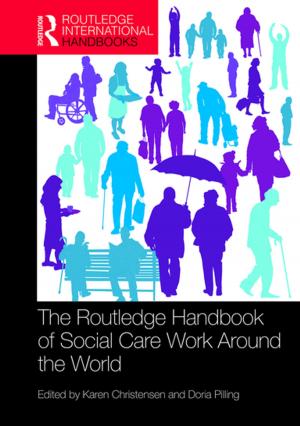Cross-cultural Communication and Aging in the United States
Nonfiction, Reference & Language, Language Arts, Communication| Author: | ISBN: | 9781136686009 | |
| Publisher: | Taylor and Francis | Publication: | October 18, 2013 |
| Imprint: | Routledge | Language: | English |
| Author: | |
| ISBN: | 9781136686009 |
| Publisher: | Taylor and Francis |
| Publication: | October 18, 2013 |
| Imprint: | Routledge |
| Language: | English |
Recently, the communication discipline has devoted increasing energy toward the study of aging, yet most of the research has insufficiently addressed a crucial factor in communicative relationships--culture. Meanwhile, cross-cultural/intercultural communication has not adequately addressed the aging process. Combining three powerful elements--communication, aging, and culture--all of which have an increasingly profound impact on today's multicultural society, this book focuses on older Americans in various communicative contexts within the framework of their cultures.
Composed of original research by experts in their respective fields, the book combines communication, aging, and culture for a unique examination of those elements in American society. Section 1 deals with perspectives in cross-cultural communication and aging. These perspectives both illustrate the issues that greatly affect the lives of our elders and suggest ways to improve their status. Section 2 showcases three American co-cultures: Hawaiian, Arab, and Mormon illustrate how language, attitudes, and mentoring can serve as the links for maintaining cross-generational continuity in multicultural society. Section 3 demonstrates that many American organizations frequently contribute to the hardships that both internal elder customers (employees) and external elder customers (residents and patients) must endure. Section 4 incorporates popular culture and aging. It presents the role of selective popular media in portraying our elders. Because Americans rely heavily on the media, their mediated perceptions can have a profound impact on their attitudes toward the older population.
Designed as a reader or supplementary text for college students in communication, gerontology, anthropology, sociology, and other related fields, this text can also be used by professionals in gerontological service areas, by libraries, and as a personal reference. It offers extensive appendices, figures, and tables for additional reference.
Recently, the communication discipline has devoted increasing energy toward the study of aging, yet most of the research has insufficiently addressed a crucial factor in communicative relationships--culture. Meanwhile, cross-cultural/intercultural communication has not adequately addressed the aging process. Combining three powerful elements--communication, aging, and culture--all of which have an increasingly profound impact on today's multicultural society, this book focuses on older Americans in various communicative contexts within the framework of their cultures.
Composed of original research by experts in their respective fields, the book combines communication, aging, and culture for a unique examination of those elements in American society. Section 1 deals with perspectives in cross-cultural communication and aging. These perspectives both illustrate the issues that greatly affect the lives of our elders and suggest ways to improve their status. Section 2 showcases three American co-cultures: Hawaiian, Arab, and Mormon illustrate how language, attitudes, and mentoring can serve as the links for maintaining cross-generational continuity in multicultural society. Section 3 demonstrates that many American organizations frequently contribute to the hardships that both internal elder customers (employees) and external elder customers (residents and patients) must endure. Section 4 incorporates popular culture and aging. It presents the role of selective popular media in portraying our elders. Because Americans rely heavily on the media, their mediated perceptions can have a profound impact on their attitudes toward the older population.
Designed as a reader or supplementary text for college students in communication, gerontology, anthropology, sociology, and other related fields, this text can also be used by professionals in gerontological service areas, by libraries, and as a personal reference. It offers extensive appendices, figures, and tables for additional reference.















